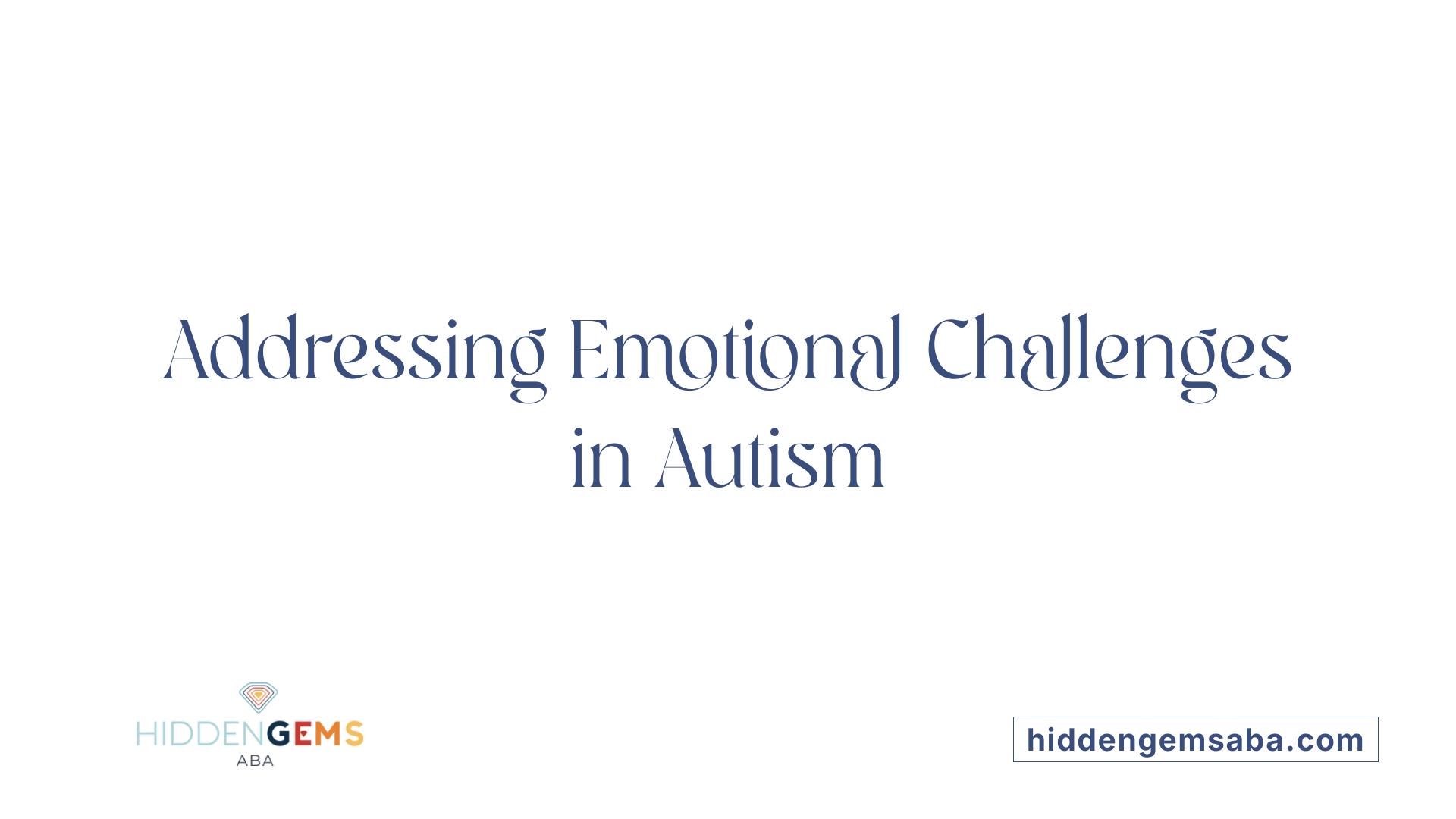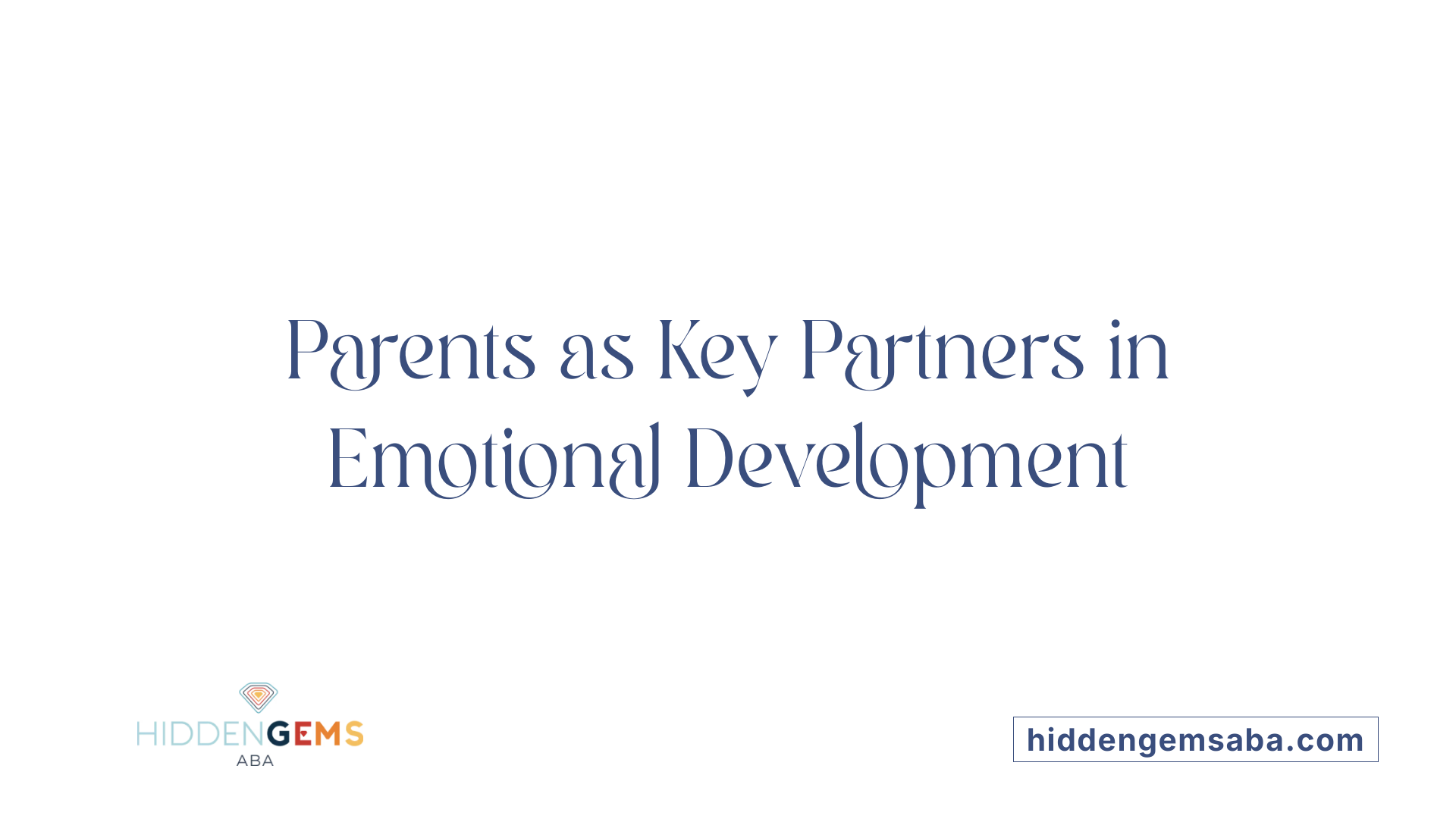Enhancing Emotional Skills in Children Through ABA Therapy
Applied Behavior Analysis (ABA) has established itself as a leading therapeutic approach for children with autism spectrum disorder (ASD), especially when it comes to supporting their emotional development. This article explores how ABA helps children recognize, understand, and regulate their feelings, fostering emotional resilience and social competence. With a focus on evidence-based techniques, the importance of early intervention, and the pivotal role of parents and educators, we delve into how ABA therapy equips children with essential emotional skills for lifelong well-being.
The Role of ABA in Emotional Development in Children
How does ABA support emotional growth?
Applied Behavior Analysis (ABA) is a structured approach that significantly contributes to the emotional development of children with autism spectrum disorder (ASD). By focusing on behavior modification, ABA helps children recognize, understand, and manage their emotions more effectively. It teaches them to identify feelings in themselves and others, an essential step toward developing emotional awareness and regulation.
ABA therapy emphasizes creating a supportive environment where children learn to express their feelings in constructive ways. Using visual tools like emotion charts, social stories, and modeling, children become more aware of their emotional states and learn appropriate responses. These methods help reduce emotional outbursts and build resilience, empathy, and perspective-taking skills.
Early intervention with ABA has been shown to promote emotional literacy, enabling children to navigate social situations and form meaningful relationships. Programs like Early Intensive Behavioral Intervention (EIBI) focus on developing these emotional skills from an early age, contributing to better long-term emotional health and social integration.
What methods are used in ABA for emotional skills?
ABA employs various evidence-based strategies tailored to each child's needs. Some of the key techniques include:
- Modeling: Therapists demonstrate appropriate emotional responses and social behaviors for children to imitate.
- Positive Reinforcement: Rewarding desired emotional expressions or behaviors encourages their recurrence.
- Visual Supports: Emotion charts, card sets, and social stories make abstract feelings more concrete and understandable.
- Role-Playing and Social Narratives: Children practice expressing and recognizing emotions in simulated scenarios.
- Reinforcement in Natural Settings: Applying these techniques in everyday environments like home and school ensures skills are generalized and maintained.
Furthermore, cognitive-behavioral tools such as emotion worksheets and relaxation strategies are integrated to bolster emotional regulation. Collaboration with parents and educators is vital, as consistent reinforcement across settings fosters the child's ongoing emotional growth.
How does ABA help children understand and manage their emotions?
Children with ASD often face challenges in understanding facial expressions, body language, and social cues, which hampers their emotional recognition and response. ABA addresses these difficulties by teaching children to label their feelings, interpret others' emotions, and respond appropriately.
Tools such as visual emotion charts and social stories clarify complex emotional concepts. Teachers and parents are encouraged to engage in regular discussions about emotions, reinforcing skills learned during therapy. Through consistent practice, children become more confident in expressing themselves, reducing frustration and anxiety.
ABA also promotes emotional resilience by encouraging empathy and perspective-taking, critical for healthy social interactions. Using reinforcement techniques, children learn that expressing emotions suitably leads to positive social outcomes, thereby increasing their motivation to develop these skills.
Creating supportive environments for emotional growth
Implementing ABA techniques in multiple settings—home, school, and community—enhances opportunities for emotional learning. A collaborative approach involving therapists, parents, and teachers ensures children receive consistent support.
Parents play a vital role by reinforcing emotional skills at home through discussions, patience, and praise. Incorporating strategies such as visual supports and role-playing into daily routines helps children generalize their skills.
Early intervention and comprehensive, multidisciplinary therapy help children with ASD develop emotional regulation, empathy, and social competence. This foundation improves their overall well-being and ability to form meaningful relationships.
| Technique | Purpose | Setting |
|---|---|---|
| Modeling | Demonstrate emotional responses | Therapy, home, school |
| Positive Reinforcement | Encourage emotional expression | All settings |
| Visual Tools | Clarify emotions, foster understanding | Throughout daily life |
| Social Stories | Teach social-emotional scenarios | Therapy, home, school |
| Role-Playing | Practice real-life emotional exchanges | Therapy, peer groups |
This comprehensive approach ensures children with ASD can navigate their emotional world more successfully, fostering independence and improved social relationships.
Techniques and Strategies in ABA to Foster Emotional Intelligence

What methods and strategies are used in ABA therapy to enhance emotional intelligence and manage feelings?
Applied Behavior Analysis (ABA) employs a range of targeted methods to support emotional development and regulation in children with autism spectrum disorder (ASD). These strategies are designed to help children recognize, understand, and express their emotions effectively.
One of the primary tools used in ABA is visual supports. These include emotion cards, social stories, and visual emotion charts that teach children to identify and label different feelings. For example, emotion cards might depict facial expressions representing happiness, sadness, anger, or frustration, allowing children to connect visuals with their internal states.
Social stories are personalized narratives that depict everyday scenarios involving emotional interactions. These stories help children understand social cues, appropriate responses, and emotional outcomes in various situations. Additionally, programs like the Zones of Regulation categorize emotional states into zones such as
Benefits of ABA Therapy in Promoting Emotional Growth

What are the benefits of ABA therapy for emotional development in children?
ABA therapy offers numerous benefits for emotional development in children, particularly those with autism spectrum disorder (ASD). It helps children learn to recognize, label, and express their feelings in more effective ways. By using visual tools like emotion charts, social stories, and modeling, ABA enhances emotional literacy, making it easier for children to understand their own emotions and those of others.
One of the main advantages of ABA is its focus on developing emotional regulation. Through structured sessions, children are introduced to strategies such as positive reinforcement, self-monitoring, and coping techniques that help them manage intense emotions like frustration or anxiety.
ABA therapy also encourages emotional resilience and boosts confidence by creating a supportive environment where children feel safe to explore their feelings. It emphasizes empathy and perspective-taking—core aspects of social-emotional skills—by teaching children how to understand and respond to social cues.
Therapists often employ play-based and modeling activities, which are engaging ways to practice social interactions and emotional recognition. These interventions strengthen emotional understanding and improve communication skills.
Parental involvement is a vital part of ABA. When parents reinforce these skills at home through discussion, patience, and positive reinforcement, children can generalize their learning across different settings.
Overall, ABA fosters a balanced emotional development, empowering children to navigate their feelings and build meaningful relationships. Its structured yet adaptable approach supports children in developing confidence, empathy, and emotional resilience—all crucial for thriving socially and emotionally.
The Effectiveness of ABA on Emotional Development in Children with ASD
How effective is ABA therapy in fostering emotional growth in children, including those with autism?
Research findings consistently show that Applied Behavior Analysis (ABA) therapy significantly contributes to the emotional development of children with autism spectrum disorder (ASD). This therapeutic approach employs structured, evidence-based techniques to teach social, emotional, and communication skills. Children undergoing ABA therapy experience notable improvements in their ability to recognize, understand, and express emotions.
ABA programs are tailored specifically to each child's needs, integrating positive reinforcement, modeling, and social narratives to support emotional awareness. Therapies are often delivered in individual sessions, with intensive programs involving 20 to 40 hours per week, especially when started early. These early, focused interventions have proven particularly effective in developing emotional regulation and social interaction skills.
Research indicates that structured ABA sessions help children understand and manage their emotions better. For example, tools like visual emotion charts and social stories are incorporated into therapy to help children label, interpret, and respond appropriately to various emotional cues. Such techniques foster emotional literacy, enabling children to build stronger social bonds and reduce behaviors associated with emotional dysregulation.
Beyond direct therapy sessions, the benefits extend across various settings, including classrooms and homes. This consistent environment helps reinforce emotional skills, with parents and educators playing pivotal roles in supporting progress through ongoing reinforcement and communication.
Early intervention is crucial. When ABA treatments are implemented during the preschool years, the outcomes are often more favorable. Early, intensive ABA programs help children develop crucial skills in emotional regulation, social understanding, and adaptive behavior, all of which are fundamental for independence and quality of life.
In sum, ABA therapy is a well-established, highly effective approach for fostering emotional growth in children with ASD. Its structured, individualized programs can lead to meaningful improvements in emotional regulation, social interactions, and overall well-being, supporting children’s development into more engaged and resilient individuals.
Understanding Autism’s Impact on Emotional Development and ABA Solutions

How does autism affect emotional development, and how can ABA therapy address these challenges?
Children with autism spectrum disorder (ASD) often face notable difficulties with emotional understanding, regulation, and social connection. These challenges stem from neurodevelopmental differences that impact brain regions responsible for processing social-emotional cues. For example, autistic children may focus more on facial features like the mouth rather than the eyes, making it harder to interpret others’ feelings accurately. They may also struggle to recognize and label their own emotions, leading to frustration or withdrawal.
Autism can also influence how children express emotions. Limited facial expressions or gestures can make it difficult for others to identify what the child is feeling, further complicating social interactions. These emotional hurdles can result in increased anxiety, social isolation, and difficulty forming meaningful relationships.
Applied Behavior Analysis (ABA) offers a structured, evidence-based approach to tackling these challenges. ABA therapy focuses on teaching children to recognize, label, and express emotions effectively. Using tools such as visual emotion charts, social stories, and role-playing, therapists help children understand their feelings and respond appropriately to social cues.
Through individualized sessions, ABA emphasizes reinforcing positive emotional expressions and appropriate responses, encouraging gradual improvement in emotional regulation. Techniques like modeling behavior, reinforcement, and naturalistic teaching methods are employed to embed these skills into daily life.
Importantly, ABA also aims to develop communication skills, which are vital for emotional expression. When children improve their ability to communicate, they are better equipped to share their feelings and understand others. This leads to enhanced social interactions and emotional resilience.
Research confirms that intensive ABA interventions can produce significant gains in emotional understanding, regulation, and social relationship building. Over time, children learn to manage their emotions more effectively, leading to better engagement with peers and caregivers.
In summary, ABA therapy directly addresses the emotional development challenges faced by children with ASD. By promoting emotional literacy, strengthening communication, and encouraging social engagement, ABA supports children in navigating their emotional world more confidently.
Strategies for Supporting Emotional Growth in Educational and Community Settings

How can educators and therapists support emotional growth in children through ABA therapy?
Supporting emotional development in children with autism spectrum disorder (ASD) involves targeted strategies that help them recognize, understand, and regulate their feelings. In educational and community settings, ABA therapy employs various techniques to facilitate this growth.
One effective method is labeling emotions. By explicitly teaching children to identify and name different feelings, therapists and teachers foster emotional awareness. Visual supports, such as emotion flashcards, charts, and social stories, serve as practical tools to help children connect facial expressions and body language with specific emotions. These visual aids simplify complex concepts, making emotional understanding more accessible.
Play interventions play a vital role in this development process. Structured play activities, free play, and sensory-based play are used to encourage social interaction and emotional resilience. For example, role-playing scenarios or using social stories help children practice expressing their feelings and responding appropriately to others.
Reinforcement strategies, such as praise or tokens, are used to encourage positive emotional responses and successful social interactions. Modeling appropriate emotional expressions and behaviors provides children with concrete examples to imitate, strengthening their social-emotional skills.
Creating consistent and predictable routines is also crucial, as it provides a stable environment where children feel safe to explore and express their emotions. An individualized approach respecting each child's unique needs and pace supports emotional stability and growth.
Parent and caregiver involvement enhances these strategies outside formal settings. Training on how to reinforce emotional skills at home through discussions, patience, and positive reinforcement ensures consistency and encourages ongoing development.
In summary, by integrating emotion labeling, visual supports, play-based interventions, reinforcement, and consistent routines, educators and therapists can significantly support emotional growth in children with ASD, fostering their independence and overall well-being.
The Role of Parents and Caregivers in Emotional Development

How can parents and caregivers support emotional growth in children through ABA therapy?
Parental involvement plays an essential role in reinforcing the skills children learn during ABA therapy. By actively participating at home, parents and caregivers can create a consistent, supportive environment that nurtures emotional development.
One of the most effective strategies is to incorporate regular discussions about emotions. Using visual tools like emotion charts and social stories helps children recognize, label, and understand their feelings better. These tools make abstract emotions more concrete and accessible, especially for non-verbal children.
Patience and positive reinforcement are vital. Encouraging children when they attempt to express or regulate their emotions boosts their confidence. Celebrating small successes fosters a sense of achievement and motivates continued effort.
Establishing a routine that includes emotional recognition activities ensures these skills are practiced consistently. For example, dedicating a few minutes daily to discuss feelings or share emotional experiences can be very beneficial.
Collaboration with therapists is also crucial. When parents communicate regularly with ABA therapists, they can ensure that the strategies used in therapy are reinforced at home. This cohesive approach enhances the child's learning and generalizes skills across multiple settings.
Creating a nurturing environment involves demonstrating empathy and patience. When children sense that their caregivers are understanding and supportive, they feel safe to explore and express their emotions.
In summary, by integrating emotional recognition tools into daily routines, maintaining patience, and working closely with professionals, parents and caregivers provide the foundation necessary for children with ASD to develop emotional resilience, build meaningful relationships, and succeed socially.
This collaborative, caring approach helps children navigate their emotional worlds more effectively and supports their overall well-being, fostering growth both at home and in broader community contexts.
Creating a Supportive Environment for Emotional Growth
How can educators and therapists support emotional growth in children through ABA therapy?
Educators and therapists play a vital role in nurturing emotional development in children with autism spectrum disorder (ASD). Through ABA therapy, they utilize various strategies designed to enhance understanding, regulation, and expression of emotions.
One fundamental approach involves the use of visual aids, such as emotion flash cards, charts, and social stories. These visuals help children recognize and label their feelings, making the abstract concept of emotions more concrete and accessible. By integrating these tools into daily routines and natural settings, children learn to identify their emotions accurately and respond appropriately.
Play-based interventions are also central to ABA strategies. Structured play, free play, and sensory activities provide opportunities for children to engage socially and emotionally. These activities foster resilience, promote social interactions, and create safe spaces for emotional exploration.
Reinforcement and modeling are essential techniques used by therapists. Positive reinforcement encourages children to exhibit desired emotional responses, while modeling demonstrates appropriate ways to manage feelings. Social stories, tailored narratives that depict real-life scenarios, are effective in teaching children how to navigate emotional challenges.
Creating predictable routines and stable environments supports emotional well-being. Clear schedules and consistent responses reduce anxiety and provide a sense of security. Respectful, individualized approaches acknowledge each child's unique needs, fostering trust and emotional stability.
Involving family members and educators in this process ensures consistency across different settings. Parents trained in ABA techniques can reinforce emotional skills at home through discussion, patience, and supportive reinforcement.
By integrating these strategies into everyday interactions and routines, educators and therapists help children develop emotional resilience, social competence, and independence. Ultimately, fostering a supportive environment lays the foundation for children with ASD to thrive emotionally and socially.
How does creating routines and involving family and teachers support emotional growth?
Structured routines and predictable environments provide a sense of safety and consistency for children with ASD. Knowing what to expect minimizes stress and helps children focus on learning emotional and social skills.
When families and teachers actively participate in ABA interventions, they reinforce emotional understanding and regulation across different contexts. Consistency in responses and strategies ensures children can generalize skills learned in therapy to home, school, and community settings.
Moreover, involving everyone in the child's care promotes a unified approach that supports emotional stability. Regular communication, training, and shared goals help maintain a structured environment conducive to emotional growth.
In summary, fostering a predictable and collaborative environment, tailored to each child's needs, is essential for successful emotional development and social integration.
Fostering Emotional Well-Being in Children with ABA
Supporting emotional development in children, especially those with ASD, requires a multifaceted approach that combines evidence-based ABA techniques, active involvement of parents and educators, and a nurturing environment. ABA therapy provides practical tools and strategies such as visual supports, social stories, and modeling, which help children recognize, express, and regulate their emotions. Early intervention and consistent reinforcement across settings enhance social interactions, build emotional resilience, and promote lifelong skills. By fostering emotional well-being through these tailored interventions, we empower children to navigate their feelings confidently, develop meaningful relationships, and thrive socially and emotionally.
References
- The effectiveness of applied behavior analysis program training on ...
- Teaching Emotional Intelligence with ABA - Therapyland
- Nurturing Emotional Development in Autistic Children
- How Does Autism Affect Emotional Development? - Jade ABA Therapy
- ABA Therapy and Emotional Development in Children
- 7 Surprising Benefits of ABA Therapy for Kids You Need to Know
- Applied Behavior Analysis (ABA) | Autism Speaks
- 6 Life-Changing Benefits of ABA Therapy for Children with Autism
- Applied Behavior Analysis: What Is It and How Does It Work? - WebMD
- Understanding Emotional Development and ASD





